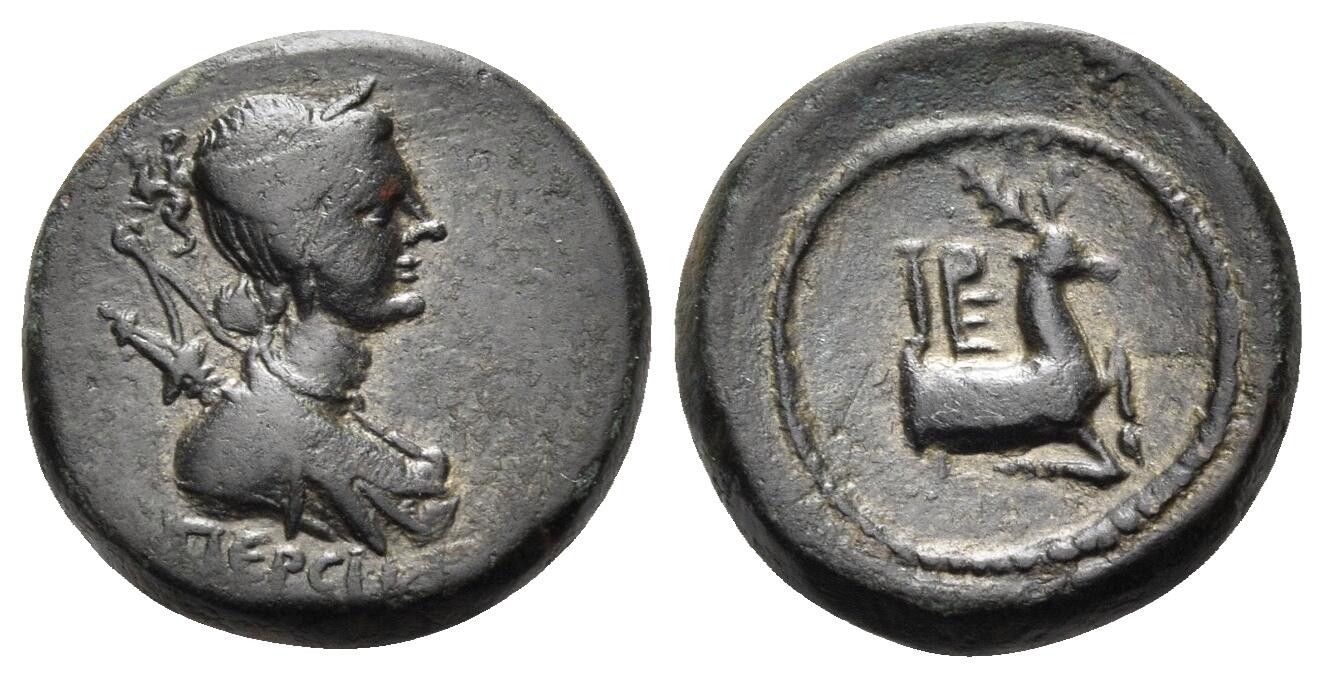S 1162 - Hieracome-Hierocaesareia, bronze (Artemis/deer) (100-30 BCE)
From SILVER
100 BCE - 30 BCE Bronze
Description
| ObverseInscription or printing placed on the obverse.: | (ΠΕΡΣΙΚΗ) (Greek).Different types: 1) Head of Apollo right, wearing laurel wreath (group 1), 2) Bust of Persian Artemis right (group 2-3), 3) Draped bust of Artemis right (group 4), 4) Head of a Persian right (group 5). |
| ReverseInscription or printing placed on the reverse.: | Monogramm of the city (IEP) (Greek).Several types: 1) Bow and quiver within laurel wreath, in field, monogram (group 1), 2) Forepart of deer right (groups 2-3), 3) Forepart of deer right (group 4), 4) Artemis right, holding a deer (group 5). |
Mint and issuing power
| MintIdentifies the place of manufacture or issue of a numismatic object.: | Hierocaesareia | Ancient regionAncient region.: | Lydia | Modern countryModern country: Turkey | AuthorityIdentifies the issuing power. The authority can be "pretended" when the name or the portrait of X is on the coin but he/she was not the issuing power. It can also be "uncertain" when there is no mention of X on the coin but he/she was the issuing power according to the historical sources: |
Chronology
| FromIdentifies the initial date in a range assigned in a numismatic context. | 100 BCE | toIdentifies the final date in a range assigned in a numismatic context.. | 30 BCE | PeriodTime period of the numismatic object.: Hellenistic 323-30 BC |
Physical description
| MetalThe physical material (usually metal) from which an object is made.: | Bronze |
Median weightMedian of the weights of numismatic objects (in grams). in grams | 5.50 | DenominationTerm indicating the value of a numismatic object. Examples: tetradrachm, chalkous, denarius.: | StandardStandard.: |
Image

S1162 Hierocaesareia.jpg [1]
References
| Die study referencePublication of the study: | Hochard 20201Hochard 2020, p. 146, Series 1, Groups 1-5, n° 612-616 | ||
| Coin series referenceReference to coin series study: | |||
Obverse dies distribution
| FrequencyFrequency of specimen in distribution. ᵖ | Number of obversesNumber of obverse dies. ᵖ (o) | % (o) | Number of coinsNumber of coins. (n) | % (n) | Die nameName(s) of the die(s). |
| 1 | 4 | 50 | 4 | 30.77 | |
| 2 | 3 | 37.5 | 6 | 46.15 | |
| 3 | 1 | 12.5 | 3 | 23.08 | |
| Total | 8 of 8 | 100 | 13 of 13 | 100 |
Reverse dies distribution
no distribution is available
Quantification
| Number of obversesNumber of obverse dies. ᵖ (o) | 8 | Number of singletons (o1)The number of singleton coins. ᵖ | 4 |
| Number of reverse diesNumber of reverse dies. (r) | 7 | Number of coinsNumber of coins. (n) | 13 |
| Coins per obverse dieNumber of coins per obverse die. (n/o) | 1.63 | Coins per reverse dieNumber of coins per reverse die. (n/r) | 1.86 |
| Reverse per obverse ratioRatio of obverse dies divided by reverse dies. (r/o) | 0.88 | Percentage of singletons (o1)number of coins (n) divided by the number of singletons (o1) ᵖ | 50 % |
| Original number of dies (O) (Carter 1983 formula)The estimation of the number of coins according to Carter 1983 ᵖ | 16.76 | Coins struck if 20,000 as average productivity per dieCoins made if the average productivity for obverses (according to Carter) is 20,000. ᵖ | 335,200 |
| Original number of dies (O) (Esty 2011 formula)The estimation of the number of coins according to the singleton formula in Esty 2011 ᵖ (O) | 20.8 | Survival rate if 20,000 as average productivity per dieSurvival rate if average productivity is 20,000. ᵖ | 0.00004 |
| Coverage (o = % of O) (Esty 1984 formula)Esty 1984 - coverage (% of O) ᵖ (o = % of O) | 69.23% | Die productivity if survival rate 1/2,000Average productivity if survival rate is 1/2,000. ᵖ | 1,551.31 |
| Weight of silver (in kg) if 20,000 coins per die (O = Carter formula)Carter 1983 * Median weight * 20000 (*10 if gold or electrum) ᵖ | n.a. | Die productivity if survival rate 1/5,000Average productivity if survival rate is 1/5,000. ᵖ | 3,878.28 |
Remarks